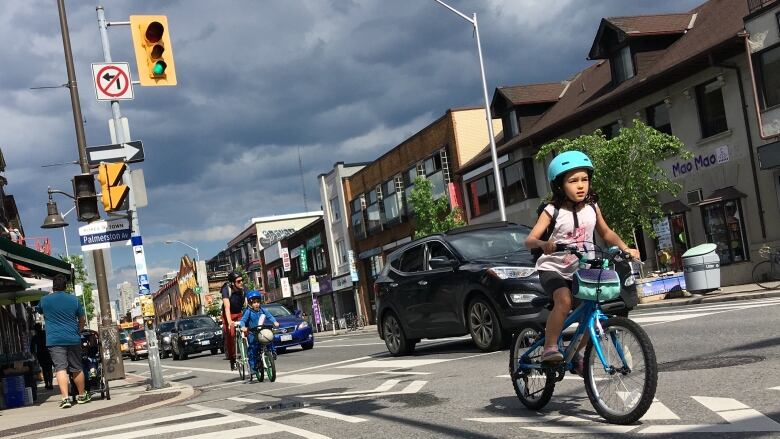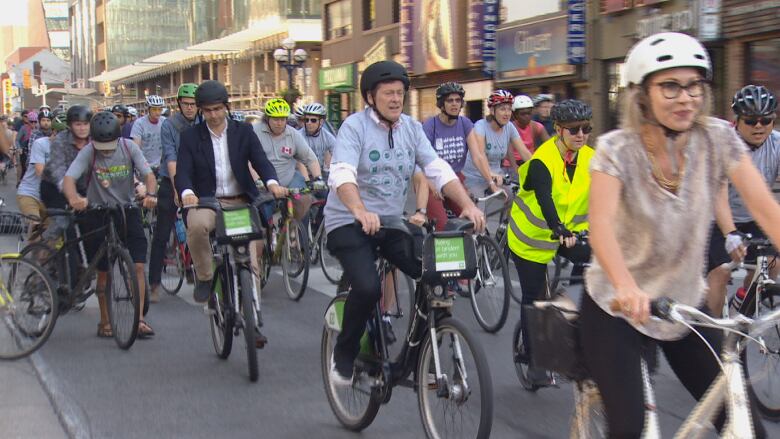Toronto cyclists calling for Bloor Street bike lane pilot project to be made permanent
Spring survey of 14K finds cyclists feel safer in lanes, but motorists still dissatisfied during rush hour

It took years to get bike lanes on Bloor Street, and Toronto cycling advocates aren't waiting to put pressure on the city to keep them now that they're there.
- Toronto's big cycling challenge? Coaxing nervous riders onto the road
- Toronto launches review into keeping cyclists safe after 5-year-old boy's death
City council will decide the fate of the lanes, which opened last August and run between Shaw Street and Avenue Road, this fall.
This Thursday, students from five schools located near the lanes will hold an event calling for them to be maintained.Next Monday, city staff will hold a public meeting to release the results of a second survey that heard from some 14,000 people and also provide details about a technical evaluation of the route. And Cycle Toronto leaders have called it the "linchpin" of the city's future cycling network, and are calling for its expansion.
Room for improvement?
Coun. Joe Cressy, a proponent of the lanes that run through his TrinitySpadinaward, said the latest reports are good news.
"Is the street moving more people safely? It is," he told CBC Toronto.
"That's a success. Is there room for improvement? Absolutely. And that's what we're working on now."

Mayor John Tory, speaking to hundreds of commuters who came to city hall to launch bike monthon Monday, won applause for noting the pilot project's apparent popularity but said the city would have to wait for a final evaluation before making a decision.
"It's gone through its ups and downs, I'm being honest about this," Tory said, before detailing the lanes' positive start, a negative stretch during the winter months and an upswing again in recent months, something he attributes to people getting used to change.
"It's something that we've learned a lot from," he told the crowd.
More cycling traffic
City data released in February showed there's been a 36 per cent increase in cyclist traffic on Bloor, with some 4,500 people using the lanes every day. Transportation staff estimated about a quarter of that new traffic was driven by new cyclists.
Drivers, however, dealt with between four- and eight-minute slowdowns on rush hour commutes.
Cressy admits the project has had "growing pains," but that it's constantly being tweaked. He's hoping that timing changes implemented in recent weeks will make a difference.
It's working, but we think it could work better.- Coun. Joe Cressy on BloorStreet bike lanes
Drivers, who made up just more than fifth of those who responded the the city's latest survey, reported that they're still dissatisfied with rush hour traffic. However, many also said they were more comfortable driving next to cyclists thanks to the lanes, although there are still issues with making right turns.
Cyclists also flagged issues at intersections, but indicated strong support for the lanes.
Businesses reported issues with deliveries, something Cressy said the city is addressing by adding drop-off zones on adjacent streets.
Interestingly, the majority of pedestrians who neither bike nor drive strongly support the bike lanes. The majority of motorists who never cycle on Bloor, on the other hand, don't feel like the lanes are worth it.
Cressy said in his ward, most residents tell him: "it's working, but we think it could work better."












_(720p).jpg)


 OFFICIAL HD MUSIC VIDEO.jpg)
.jpg)



























































































